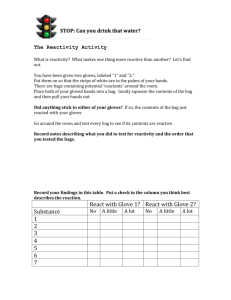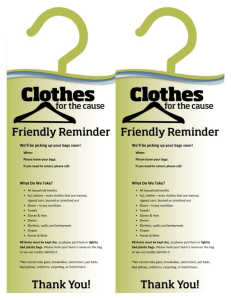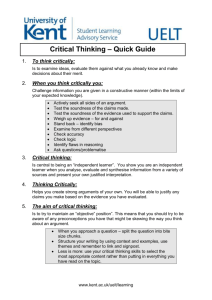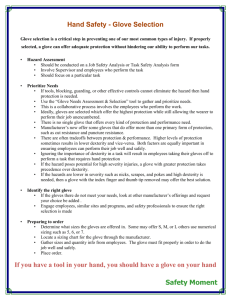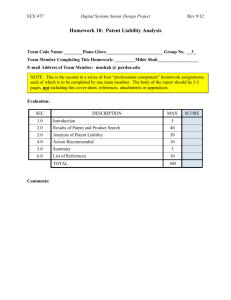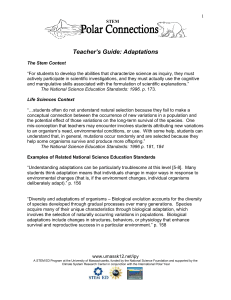INTEGRATED UNIT MATERIAL WORLD TERM 4
advertisement
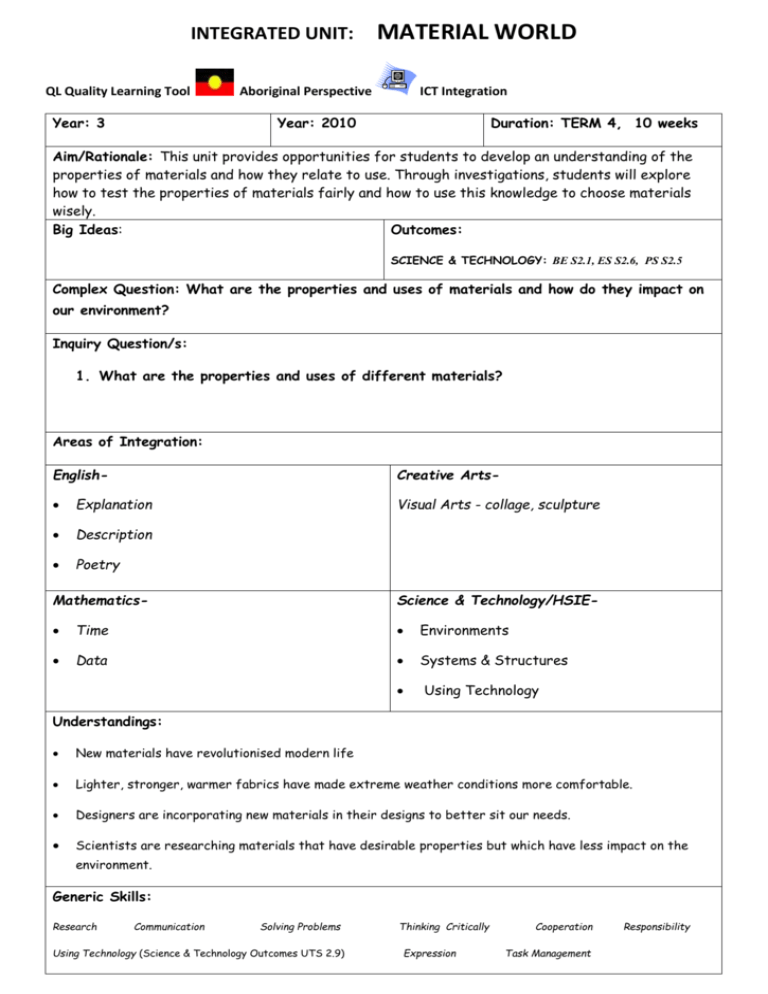
INTEGRATED UNIT: QL Quality Learning Tool Year: 3 MATERIAL WORLD Aboriginal Perspective ICT Integration Year: 2010 Duration: TERM 4, 10 weeks Aim/Rationale: This unit provides opportunities for students to develop an understanding of the properties of materials and how they relate to use. Through investigations, students will explore how to test the properties of materials fairly and how to use this knowledge to choose materials wisely. Big Ideas: Outcomes: SCIENCE & TECHNOLOGY: BE S2.1, ES S2.6, PS S2.5 Complex Question: What are the properties and uses of materials and how do they impact on our environment? Inquiry Question/s: 1. What are the properties and uses of different materials? Areas of Integration: English- Creative Arts- Explanation Description Poetry Visual Arts - collage, sculpture Mathematics- Science & Technology/HSIE- Time Environments Data Systems & Structures Using Technology Understandings: New materials have revolutionised modern life Lighter, stronger, warmer fabrics have made extreme weather conditions more comfortable. Designers are incorporating new materials in their designs to better sit our needs. Scientists are researching materials that have desirable properties but which have less impact on the environment. Generic Skills: Research Communication Solving Problems Using Technology (Science & Technology Outcomes UTS 2.9) Thinking Critically Expression Cooperation Task Management Responsibility FOUNDATION STATEMENTS: ENGLISH: Students write well-structured literary and factual texts in terms of topic, purpose, audience and language by drafting, revising and proof-reading. Students communicate proficiently ideas and information in classroom, school and social situations for a range of purposes. They explore a range of roles when interacting in pairs and groups, using various listening strategies to gather general ideas from conversations, reports or spoken presentations. HSIE: Students explore change in communities from different perspectives and evaluate the effects of change on individuals and groups, including Aboriginal peoples, and the environment. They understand key events related to the British colonisation of Australia and identify the changes and consequences for Aboriginal and other peoples and the continent. Students explain how different cultures and traditions contribute to Australian and community identity. They examine a variety of local and other communities, investigating similarities and differences including ways of living, languages and belief systems. Students identify, locate and describe natural, heritage and built features in the local area and in other parts of Australia and explain their significance and management. They locate the four compass points and other significant features on a map and develop skills to locate and evaluate information from a variety of sources. CREATIVE ARTS: Students make artworks that represent a variety of subject matter and make choices about the forms and techniques used to best represent the qualities of the subject matter. They discuss reasons why artists make particular artworks and why different interpretations are possible, recognising similarities and differences in how subject matter is represented. MATHEMATICS: Students gather and organise data to create and interpret tables and graphs. Students use coordinates to describe position and compass points to give and follow directions. SCIENCE & TECHNOLOGY: Students select and safely use equipment, computer-based technology and other resources throughout the processes of investigation. Preparing the Learning Environment: Display complex & inquiry questions Display texts/websites/stimulus posters Prepare interactive word bank Establish a “Did you know?” board with facts Australian and world maps Magazine & Newspaper articles Display generic skills Organise excursion Prepare wall display Resources: Bulk loan of suitable library books on natural and processed materials Sets of guided reading texts Teachers BLM books: Primary Connections Stage 2-Material World; Excel Science & Tech 3-4 What’s It Made Of?; New Science & Technology Today 3 - What’s It Made Of? Initiating the Unit: Introduce questions and resources Introduce generic skills Find out what the children already know and what they want to find out Inquiry Question: Duration: 3 weeks Wks: 1 - 3 1. What are the properties and uses of different materials? Teacher Conference Product Analysis Planned Observation TEACHING & LEARNING EXPERIENCES: Assessment Product Student written responses Communication and oral Read a book about clothing in different Clothes – and discuss the properties of the Generic Skills Tuning In parts of the world – Around the World Outcomes/ √ clothes shown and their suitability for the climate and purpose. Ask questions such as: When would you wear gumboots> Why? and, Would you wear a coat Communication in the desert? Why? Define the terms: object, materials and properties. Demonstrate their meaning using an item of clothing found in the classroom. Record responses to the questions in the student’s Integrated Unit books. e.g; The object is a _________ √ The __________ is made of _________. _________was used because _________. √ Materials Expression Snapshot Communication Display Create a “materials snapshot” using stick-it notes. Students write statements about various materials, their properties and their uses e.g. Rubber is bendy and can be used in shoes; Plastic is waterproof and can be used in raincoats; Paper is flat and tears easily and it is good for writing on. Show the students the Powerpoint on Gloves. Discuss the different types of gloves shown and discuss their properties and uses. Show the students a variety of gloves (teacher to bring in a selection of gloves) and allow them to examine each one and in small groups discuss their properties and possible uses. Ask the students why the materials used would have been chosen for √ Research Cooperation Task Management each glove. Ask questions such as: What √ Completed might this glove be used for? What is it Resource made of? Why is it made of that material? sheet 1 Expression Communication What else could it be used for? Provide the students with a copy of the Journal entry ‘glove guide’ (Resource sheet 1). Model on an enlarged copy an annotated drawing of a glove including materials used, properties of the materials & uses for the glove. Students complete a Science Journal entry √ in their books using the following sentence Homework project starters: Things I think I know about the properties and uses of materials are......... Things I am interested in finding out are...... Provide students with the “Bags at Home Project” to be completed as Homework. Research Finding Out Cooperation Fair testing. Conduct a Clothes Relay activity (see pp16-17 Primary Connections) Student in order to demonstrate the concept of fair reponses testing. Discuss the variables which may Expression have affected the outcomes of the test Communication (relay) e.g. number of clothes, length f run, number of team members, speed of runners. Discuss ways of ensuring the variables in √ √ any scientific test Do NOT affect the outcomes of the test i.e. that conditions, materials and environment are the same. Science Journal Conduct the test Rot or Remain (see Primary √ entry Connections pp 18-21) making sure it is a ‘fair test’. Students record their predictions and observations in their books as a Journal entry. Conduct the test, Leak, Soak or Repel? (see √ √ √ √ Completed worksheet. Primary Connections pp 22-27) ensuring it is a fair test. Students record their predictions and observations on Resource sheet 4. Conduct the test, Snap, Tear or Stretch (see Primary Connections pp 30-34) ensuring it is a fair test. Students record their Task Management Completed worksheet. predictions and observations on Resource sheet 5. Sorting Out Discuss how different properties make materials suitable or unsuitable for certain objects. Student √ Responses Ask questions such as: What properties do the materials for a sponge need? Thinking Critically What properties would you want a winter Research coat to have? Cooperation Would you make a shopping bag out of bricks? Why? Why not? Student √ Responses Communication Would you make a belt out of marshmallow? Task Why? Why not? Management Ask students to recall what they discovered Student √ Responses about bags from their “Bags at Home Project”. Ask students to tell of their experiences √ carrying objects in bags and refer to the Completed properties of the materials used to make Worksheet the bag. Thinking Critically Show the students the 5 numbered and labelled bags to be used for “The Carrying Dilemma” (Resource Sheet 6). Students are Expression √ to match a bag with an item to be carried. responses students into learning groups. Each group to report back to the class on their findings. Return to the “Rot or Remain” test begun in Solving Student Each bag can only be used once. Divide √ Student √ responses an earlier session. Students retrieve their samples and record their observations under the heading “Rotten Results”. Discuss the results with the whole class. What types of materials rotted? Which types did not rot? What may have caused some things to rot and not others? Discuss biodegradable materials by asking √ Student responses Problems questions (see PC Unit p43). Read and then paste Puzzling over Plastic (Resource sheet 7) into books. Student Making Connections Ask students to suggest materials that might be good at keeping things warm. (Look back over earlier work on properties of responses. Solving Problems Thinking Critically √ materials used in clothing). Task Managament Explain that we are going to investigate the Communication question Which material keeps things the warmest? Explain the investigation as outlined on p50, Student Primary Connections. Discuss the variables participation. that might affect the temperature of the Completed water and the rate at which the planner. temperature drops. Introduce the large copy of “Keeping It Warm” (Resource sheet 8).Discuss and model how to complete this planner. Model how to set up and perform the Student investigation (p50) responses. Students conduct investigations and record Graph. their findings in their Science Journal. Task Management Communication Student responses. Model how to construct a graph to visually represent the information recorded in the investigation. (p51 & Resource sheet 8) Students use the Explaining Results (Resource Sheet 8) Research Going Further Review prior learning. Explain the task: to create a class book in the form of a catalogue to display suitable Communication √ Thinking √ Critically materials to be used for clothing in given situations. Provide students with scenarios that they are to design clothes for. Give students a copy of Material Matters (Resource Sheet 9). Explain that they will create a drawing of clothing which suits the scenario given. Students are to annotate the Annotated √ √ design. materials chosen for their outfit and to give reasons for their choice. Compile the sheets into a class catalogue. Thinking Critically Reflecting and Acting Students review their journals and worksheets and reflect on their learning during the unit. Expression √ Communication Provide questions to guide student Student reflections: responses. What new things did I learn during this unit? What activity did I enjoy most and why? What activity was the most challenging>? Why? What am I still wondering about? What skills did I improve when working in teams? Students share one of their reflections with the whole group. √ √
